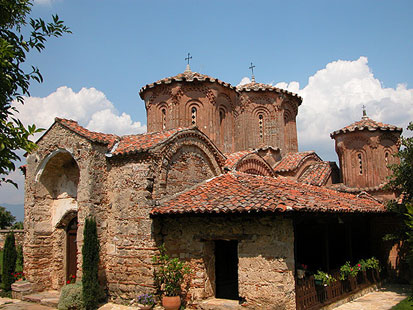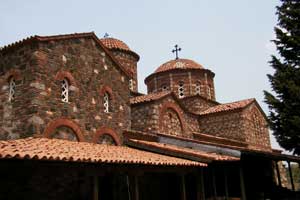Well-known Churches and Monasteries
- St. Panteleimon,
village of Gorno Nerezi, Skopje - St Andrew, Matka
- St. Nicholas of Šiševo, Matka
- St. Nicetas, village of Banjani, Skopska Crna Gora
- The Holy Saviour, Skopje area
- The Holy Great-martyr George,
village of Staro Nagoričino, Kumanovo area - The Holy Sophia, Ohrid
- Plaošnik, Ohrid
- St. John the Theologian - Kaneo,
Ohrid - The Most Holy Theotokos Peribleptos, Ohrid
- St. George, village of Kurbinovo, Prespa
- St. Nicholas, Varoš, Prilep
- The Polog monastery of St. George, Kavadarci area
- The Most Holy Theotokos Eleusa,
village of Veljusa - St. Leontius, village of Vodoča
- The Holy Archangel Michael, Berovo
- St. Parthenius of Zographou's monastery complex, Star Dojran
- The Dormition of the Most Holy Theotokos, Matka
- St. Nicholas, Ljubanci, Skopska Crna Gora
- Marko's monastery of St. Demetrius, village of Markova Sušica
- The Holy Saviour, Skopje
- The Holy Archangel Michael,
Varoš, Prilep - The Holy Transfiguration,
village of Zrze, Prilep area - The Dormition of the Most Holy Theotokos, Treskavec, Prilep area
- The Nativity of the Most Holy Theotokos, village of Slivnica, Prespa
- St. John the Baptist, village of Slepče, Demir Hisar area
- St. Athanasius, village of Žurče, Demir Hisar
- St. Nahum, at Ohrid
- The Bigor monastery of St. John the Baptist
- Entry into the Temple of the Most Holy Theotokos, The Most Pure, Kičevo area
- The Lesnovo monastery of the Holy Archangel Michael
The first arrival of the Holy Apostle Paul on European soil, during his proclamation of the Gospel among the Gentiles, takes place in Macedonia. Ever since, on this Balkan piece of land experienced in the broader or in a limited sense, the apostolic blessing has lain. Ever since then all the forms of ascesis in the Church have been manifested here as well. Equal to the apostles, martyrs, preachers, teachers, hierarchs, venerable ones... This land has given birth to holy souls. Notwithstanding whether or not anybody from outside, viewed from a human aspect, is willing to confirm this. Many names of anonymous saints have remained unknown throughout the centuries, yet they have been written in the Heavens. There are also many mentioned in the lives of the saints in all the local Orthodox Churches in this area.
 History writings state that Orthodox monasticism in Macedonia is for the first time renewed on a massive scale with the arrival of the saints Clement and Nahum in Kutmičevica – at that time an undeveloped area situated at the border, on the shores of Lake Ohrid – in the first half of the 10th century. In history books and scientific treatises these two enlighteners of the Macedonians are magnified by their mission of synthesis of the Cyrillic and the educational activity in Ohrid as founders of the first university of literacy in Macedonia – the so-called Ohrid School of Literacy. However, often this fact is overlooked or forgotten: the 3,500 and more disciples of St. Clement , the number of whom is mentioned in the extensive hagiography of the saint, who had gathered around him in the first seven years of his activity of a teacher in the monastery of St. Panteleimon, on Plaošnik, as well as later most of the disciples of St. Nahum in Ohrid and in the monastery of the Holy Archangels at the springs of the Crn Drim, had actually been monks. St. Clement had ordained many of them readers, deacons, and hieromonks. Later some of them were consecrated episcopes. Tradition has it that one of the disciples of St. Clement renewed the monasticism in the vicinity of the town Prilep, in Varoš, where (after the example of Ohrid) a great number of churches and monasteries were built.
History writings state that Orthodox monasticism in Macedonia is for the first time renewed on a massive scale with the arrival of the saints Clement and Nahum in Kutmičevica – at that time an undeveloped area situated at the border, on the shores of Lake Ohrid – in the first half of the 10th century. In history books and scientific treatises these two enlighteners of the Macedonians are magnified by their mission of synthesis of the Cyrillic and the educational activity in Ohrid as founders of the first university of literacy in Macedonia – the so-called Ohrid School of Literacy. However, often this fact is overlooked or forgotten: the 3,500 and more disciples of St. Clement , the number of whom is mentioned in the extensive hagiography of the saint, who had gathered around him in the first seven years of his activity of a teacher in the monastery of St. Panteleimon, on Plaošnik, as well as later most of the disciples of St. Nahum in Ohrid and in the monastery of the Holy Archangels at the springs of the Crn Drim, had actually been monks. St. Clement had ordained many of them readers, deacons, and hieromonks. Later some of them were consecrated episcopes. Tradition has it that one of the disciples of St. Clement renewed the monasticism in the vicinity of the town Prilep, in Varoš, where (after the example of Ohrid) a great number of churches and monasteries were built.
Second wave of renewal of monastic life in Macedonia in the history writings is observed from 1085 to 1106, after the consecration of the venerable father Manuel for an episcope of Tiberiopolis, at the foundation of the monastery of the Most Holy Theotokos Eleusa in the theme of Strumica, above the village called Paleokastron. The Monastery of the Most Holy Theotokos Eleusa was one of the few monasteries in the history of Orthodoxy that were neither under the jurisdiction of the local ecclesiastical authority nor under the Ecumenical Patriarch, but its Abbess is Bogoroditsa (the Theotokos), (the first superior – kathegoumenos – installed by the episcope Manuel was the hieromonk Elias). And with the chrysobull issued by the Byza ntine emperor, during the reign of the Komnenos dynasty it was given unlimited sovereign rights over its own monastery property and typikon. This monastery in the following two-three centuries became a monastic spiritual seed-plot for the monasteries in the southeast of Macedonia , by the valley of the river Bregalnica.
ntine emperor, during the reign of the Komnenos dynasty it was given unlimited sovereign rights over its own monastery property and typikon. This monastery in the following two-three centuries became a monastic spiritual seed-plot for the monasteries in the southeast of Macedonia , by the valley of the river Bregalnica.
The eremitic ascesis of St. Gabriel of Lesnovo (by the end of the 10th century) and St. Joachim of Osogovo (the second half of the 11th century) is a corner stone of the further repeated rise of coenobitic monasticism in this area all up to the 15th century invasion of the Ottoman Turks. In this period were sanctified in the monastic ascesis and active St. Nicodemus of Prilep – the Tismanan (the founder of Romanian monasticism, born in Prilep), St. Nectarius of Bitola , the disciples of the great teacher of the hesychastic prayer – St. Gregory of Sinai – the Sinaites, the disciples of St. Gregory Palamas. Macedonia , as well as the surrounding Balkan area, becomes a monastic cradle of hesychasm.
The five centuries under the Turkish yoke are a period of trials and tribulation, when Orthodox monasticism is partly scattered, withdrawn to the Holy Mountain , partly declining in number. It has the task to preserve the spiritual and national awareness in the Macedonian people – enduring everything, till the end. The period of revival in the 19th century and the activity of Cyril Pejčinović, Parthenius of Zographou – the episcope of Poljana and many others, first of all monks, is a kind of a repeated rise of the monastic avant-garde.
In the 20th century, in the period between the two World Wars, many monastics from Russia , after the October revolution, inhabited the Macedonian monasteries. They here complete their struggle preserving their faith. On the other hand, many from Macedonia become Hagiorite monks, especially in the Athonite monastery of Zographou. After the World War II it is mostly female monasticism that maintains monastic life in the monasteries in Macedonia , which during the period of socialism is marked with total anonymity, small number and withdrawal from the public. In this period invisibly, humbly, keeps vigil in prayer the great ascetic, the episcope of Velika – father Gabriel, in the Lesnovo Monastery.
After a certain period of lull and germination, the seed of monasticism began to sprout in Macedonia again - at the prayers of the Theotokos, the mother of all monastics, at the prayers of the Macedonian saints (if at all the epithet of a certain toponym can be added to the name of any saint, for the saints are intercessors before God for the whole world). The renewal came about with the arrival of the monk Nahum (together with the monk Clement) from the Gregoriou Monastery on the Holy Mountain and his consecration to a metropolitan of Strumica, in August 1995. As it had been ten centuries before this, with the arrival of the venerable Manuel from the holy monastery of St. Auxentius and his enthronement for an episcope of Ti beriopolis; as even prior to this, with the arrival of Saints Clement and Nahum, with the consecration of Clement to an episcope of Dremvica and Velika. For the episcope is the head of the Church – he is in the place of Christ; and around him assembles the Church, the Body of Christ.
beriopolis; as even prior to this, with the arrival of Saints Clement and Nahum, with the consecration of Clement to an episcope of Dremvica and Velika. For the episcope is the head of the Church – he is in the place of Christ; and around him assembles the Church, the Body of Christ.
The monastery of the Entry into the Temple of the Most Holy Theotokos Eleusa, today – from the perspective of eight years later – certainly not by accident, again, as ten centuries ago, was the spiritual nursery-garden of monasticism in Macedonia . Spontaneously, in the spirit of the millenary tradition, male monasticism was first to be renewed in it, as it to continue existing as a female coenobitic monastery a year later. Then, in 1996, first the Vodoča monastery of St. Leontius was renewed as a male monastery. Afterwards, since 1998 until now, yet other, more than twenty male and female monasteries throughout the territory of the Republic of Macedonia . Today the unofficial statistics says: approximately one in 10,000 Macedonians is a monastic.